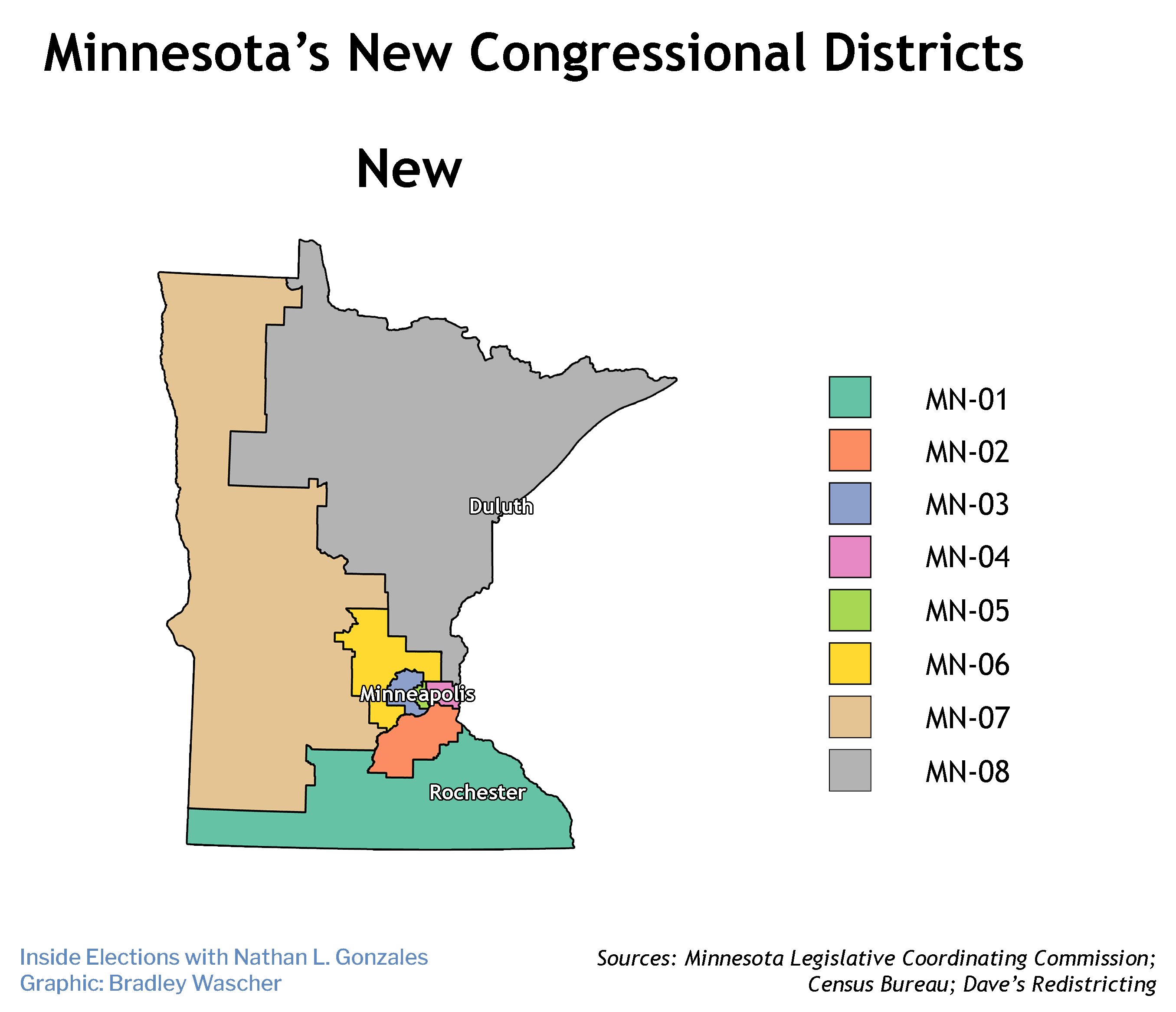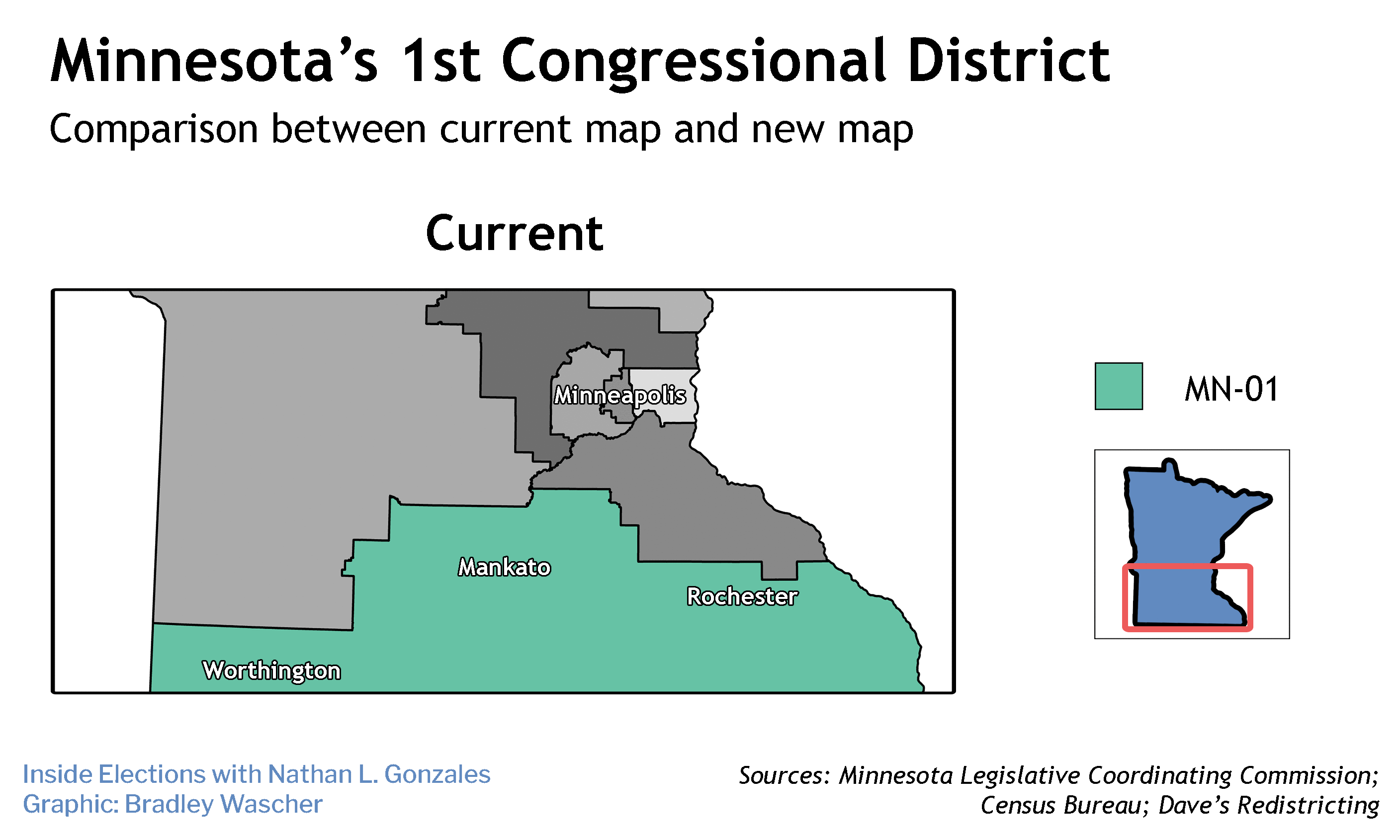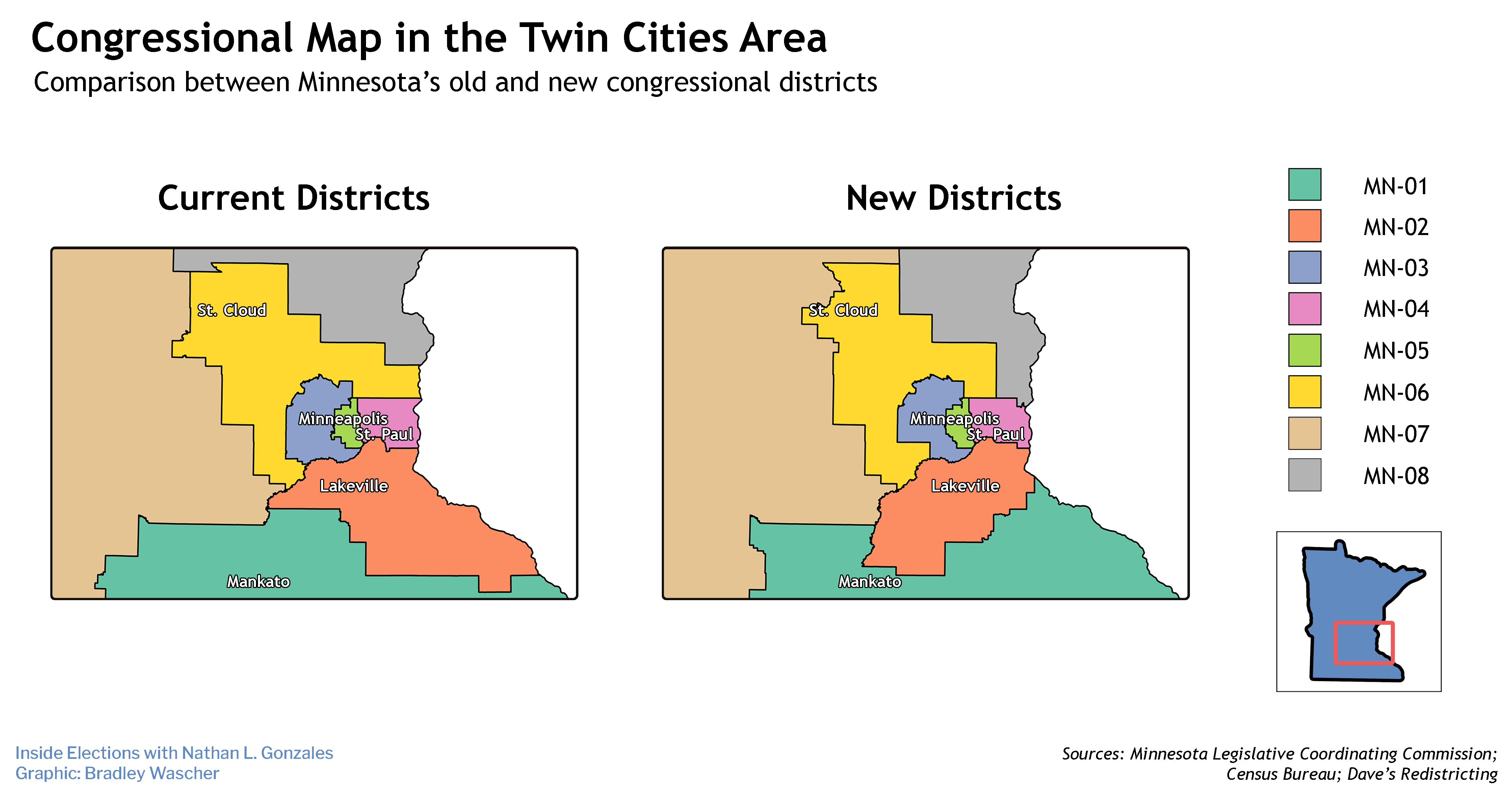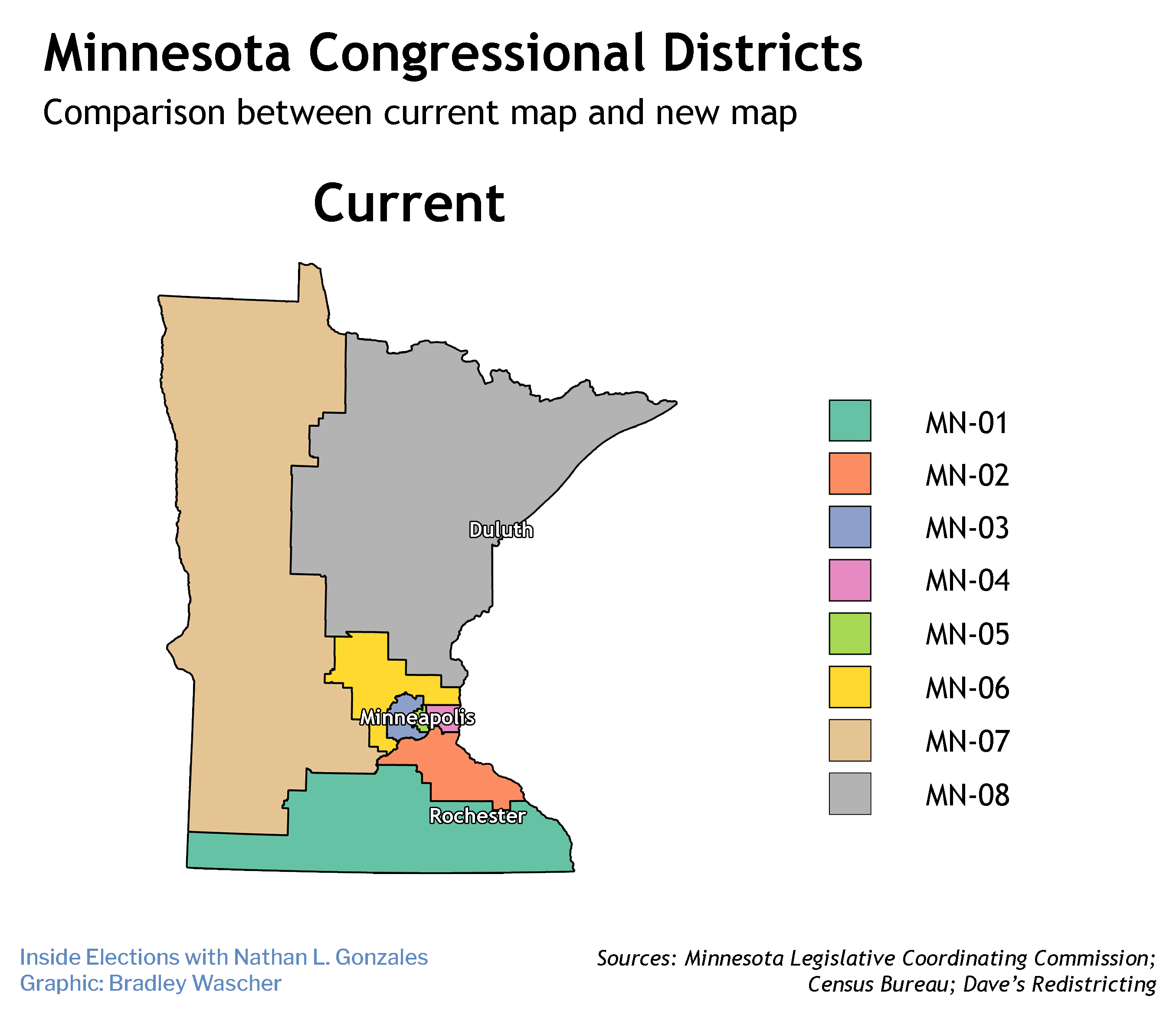Minnesota Redistricting: Land of a Couple Interesting Races
April 7, 2022 · 11:58 AM EDT
In Minnesota, reapportionment cut a little too close for comfort. Had New York State counted just 89 more people in the 2020 Census, it would have retained its 27th seat — and Minnesota would have lost its eighth seat.
But that didn’t happen, and the Land of 10,000 Lakes will remain the Land of 8 Districts for at least another 10 years.
Because Democrats failed to retake the state Senate in the 2020 elections, control of redistricting was divided between the GOP-held upper chamber, and the Democratic governor and state House. From the outset, that meant the new map was more likely than not to come from the courts, rather than the legislature. That’s how it’s happened in Minnesota for every cycle beginning in 1990.
On Feb. 15, a panel appointed by the state Supreme Court revealed its map, which is largely a status quo update from the previous decade.
While some districts had to gain or lose population to get to parity, no seat saw its overall partisanship change significantly. The state is still home to four Republican, rural and exurban districts, three Democratic urban and suburban districts, and one competitive suburban district.
The state’s delegation is currently split evenly, 4D-4R. But Republicans will have a good chance to flip one Democratic-held seat in the fall and claim a majority of the delegation for the first time since 1980.
And a special election to replace the late Rep. Jim Hagedorn, a Republican, adds a layer of uncertainty to exactly what the makeup of the delegation will be come 2023.

1st District
The 1st District will actually play host to two elections this year: the regularly scheduled race in November, and a special election to replace Hagedorn, who recently died of cancer. The primary for the special election will take place on May 24, and the general special election on August 9 — the same day as the primary for the regular November race.
Because of redistricting, the special election will take place under the old lines, while the regularly scheduled race will use the lines approved for the coming decade.
Both the old and the new 1st District are rural and sit along Minnesota’s southern border, stretching from South Dakota to Wisconsin. The 1st’s northern border was altered in the redistricting process, adding Goodhue and Wabasha, the two counties directly north of Rochester. The 1st also shed Le Sueur County and swapped out its western portion of Rice County with parts of eastern Rice. The district also gave up its Cottonwood County portion and the western half of Brown County.
The partisanship of the two iterations is roughly equivalent. Trump won the old district by 10 points, 54-44 percent. He would have won the new district by 9 points, 53-44 percent.
Ten Republicans are running in the special election, though just half that number are putting together credible campaigns: former state party chairwoman Jennifer Carnahan, who is also Hagedorn’s widow; state Reps. Jeremy Munson and Nels Pierson; former state representative/former Trump USDA Minnesota director Brad Finstad; and agriculture attorney Matt Benda.
In a low-turnout race with a wide field and no runoff threshold, it could take just a few thousand votes to win. Compounding the uncertainty is the short runway: the special election was called on Feb. 22, the filing deadline was March 15, and early and absentee voting will begin April 8.
There’s plenty of historical precedent for widows to succeed their partners in Congress, though it’s by no means a given, as Susan Wright discovered in Texas’ 6th last year. And there’s reason to believe Carnahan might struggle to leverage her position successfully. Her connection to the district is somewhat tenuous — until recently she lived in St. Louis Park, an inner suburb of Minneapolis located three congressional districts and 40 miles to the north of the 1st — and she was only married to Hagedorn for a few years, after he won his first election in 2018.
More troubling for Carnahan are the circumstances under which she left her post as party chairwoman: the indictment of GOP donor and operative Anton Lazarro on charges of sex trafficking minors. Carnahan and Lazarro were close, even hosting a podcast together, and Carnahan resigned a week after his arrest.
That baggage could leave Carnahan politically homeless, by creating an opening for other candidates to enter the race and lay claim to the Hagedorn mantle, and leaving Carnahan vulnerable from attacks by conservatives worried about losing the seat, as evidenced by a recent Breitbart News article casting her as a cynical power player who spent years angling to get to Congress.
Benda is running an agriculture-focused campaign that looks to capitalize on his roots in the westernmost part of the district, where none of the other major candidates are from, and his ties to farmers across the district through his legal practice and wife’s accounting business. He also brought on Hagedorn’s longtime consultant Gregg Peppin and pollster Brock McCleary.
Munson, the state legislator, is running as the most ideologically pure conservative candidate in the race. In the state House, Munson actually split away from the GOP leadership to form his own renegade caucus with a handful of other lawmakers, and he is leaning into that combativeness in his campaign, touting endorsements from firebrands in Congress such as Reps. Tom Massie of Kenctucky, Jim Jordan of Ohio, and Scott Perry of Pennsylvania.
Finstad, who served in the state legislature in the 2000s, is trying to cut a middle path, balancing his deep ties to the business community — he led the Center for Rural Policy and Development in St. Paul and the Minnesota Turkey Growers Association — with his Trump credentials. But of all the major candidates he’ll have to work hardest to fight back against perceptions that he’s a moderate out of step with an increasingly aggressive GOP primary electorate.
Pierson, who hasn’t garnered as much buzz as the others in the race, is focusing on his record in the legislature, particularly his advocacy on behalf of deaf and blind Minnesotans. He also runs a construction company, which lends his campaign a specific focus on manufacturing.
An endorsement from Trump could shake up the race, though it’s not obvious one is forthcoming. Carnahan recently made a pilgrimage to Mar-a-Lago, where she said the former president is keeping an eye on the race. Finstad is also a former Trump appointee.
And most outside groups may hold their fire as well. Thus far there has been no indication from the Club for Growth that the influential anti-tax group will get involved. And the House Freedom Fund, the political arm of the Freedom Caucus, includes Munson on some of their fundraising materials but hasn’t publicized its support for him, and has not spent money on his behalf. Protect Freedom PAC, the libertarian-oriented group affiliated with Sen. Rand Paul of Kentucky, may get involved in support of Munson.
Thus far the only outside spending in the race has been by Defending Main Street, a group affiliated with the Republican Main Street Caucus that says it supports “centrist Republican candidates who are willing to work across the aisle”; they have spent $35,000 on direct mail supporting Finstad.

On the Democratic side, Dan Feehan, who lost to Hagedorn in 2018 and 2020 by narrow margins, will not run, while three notable Democrats are running: former Hormel Foods CEO Jeffrey Ettinger, former George W. Bush White House lawyer/2018 Senate candidate Richard Painter, and political consultant Sarah Brakebill-Hacke.
Given his personal wealth, Ettinger likely starts as the candidate to beat. Painter ran a no-shot primary bid in 2018 against appointed-Sen. Tina Smith, garnering just 14 percent of the vote statewide. Brakebill-Hacke has a powerful story — once homeless, she began her own political consulting firm before earning an undergraduate degree from Yale last year and is now a master’s student at Cambridge — but it’s unclear if she’ll be able to raise the resources necessary to get that story in front of voters, especially with ballots arriving in mailboxes in just a few days.
Republicans begin with several significant advantages in the general special election. The partisan lean of the district is in their favor, and increasingly so. Though Trump only won the district by 10 points in 2020 vs. 15 points in 2016, he actually increased his share of the vote from 53 to 54 percent. GOP presidential nominee Mitt Romney lost the 1st in 2012, 49-48 percent. Even the Democrats who can win this district have done so by increasingly small margins — Sen. Amy Klobuchar carried it by 11 points in 2018, down from her 30-point victory in 2012, despite winning by a similar margin statewide.
Joe Biden is significantly more unpopular than he was during the 2020 election, and Democrats face headwinds everywhere, let alone rural districts with large white populations such as the 1st District (87 percent).
Moreover, the GOP nominee will get a boost from the timing of the election. The general special will take place concurrently with the regular statewide primaries, which features a crowded GOP primary for governor in the state’s marquee contest. There is no Democratic primary for governor, and Republicans are confident that will give them a turnout advantage.
If Carnahan is the nominee for either the special or regular elections, those races could get interesting given her baggage. But for now, both are rated Solid Republican.
2nd District
Even after redistricting, the 2nd District is still the most competitive of any in the state. But whereas the old district began in the southern Twin Cities suburbs and extended southeast along the Wisconsin border, the new district extends southwest, picking up some of Rice County and all of Le Sueur County while shedding Goodhue and Wabasha counties. While it’s a significant geographic change, it’s more minimal in population, given how many of the district’s residents live in the core of Dakota, Scott, and Washington counties, which appear in both iterations. Just 8 percent of the new district will be unfamiliar territory for DFL Rep. Angie Craig. Biden would have carried the new district by 7 points, the same as before.
Craig will likely face Tyler Kistner, the Marine veteran who she narrowly defeated in 2020, 48-46 percent. That race was complicated by the death of a third-party candidate shortly, which briefly led to the race being postponed several months; that candidate, Legal Marijuana Now candidate Adam Weeks, eventually garnered 6 percent of the vote.
Despite the poor national environment, Biden’s margin gives Craig the slightest bit of breathing room. Kistner is also burning through cash at an alarming rate — through the end of 2021 he had raised $1.1 million but spent $940,000, leaving him with just $170,000 in the bank at the start of 2022. Craig had $2.9 million. More importantly, there’s no third-party candidate in the race at the moment, which is helpful to Craig. Tilt Democratic.
3rd District
The center of gravity of the Hennepin County-based 3rd has shifted slightly northward, with the district shedding its small portion of Carver County in the south and grabbing the city of Anoka in Anoka County to the north.
Republicans held this seat for 58 years before Democrat Dean Phillips won it in 2018. Biden would have carried the new 3rd by 21 points, 59-38 percent, so it’s not going back to GOP hands anytime soon. Solid Democratic.
4th District
The 4th District is still anchored by St. Paul. It shed Stillwater Township in the north, and Newport and some of Woodbury in the south, but was otherwise unchanged. Longtime Rep. Betty McCollum faces a spirited primary challenge from Amane Badhasso, a community organizer and refugee from Ethiopia. McCollum had a slight financial advantage at the end of 2021, reporting $553,000 in campaign funds to Badhasso’s $250,000, but the organizer has put up strong showings in some of the pre-convention caucuses. The contest has the potential to turn into a proxy fight between McCollum and her colleague, Rep. Ilhan Omar, with whom she reportedly has a frosty relationship and who has embraced (but not endorsed) Badhasso.
Biden would have carried the new 4th by 38 points, 68-30 percent, so the winner of the Democratic primary will be a member next year. Solid Democratic.

5th District
The Minneapolis-based 5th District is largely unchanged, other than losing the city of Hopkins in the west. Rep. Ilhan Omar faces former Minneapolis City Councilor Don Samuels in the Democratic primary; Army veteran Shukri Abdirahman, former Iowa State basketball player Royce White, and “Blexit” state director Cicely Davis are running as Republicans.
All of Omar’s opponents will raise oodles of money given the intense dislike of the first Muslim congresswoman among Republicans and even some Democrats, but there’s little reason to believe they’ll have much electoral success. In 2020, Omar’s Democratic opponent raised $4.7 million, and she beat him by 19 points, 58-39 percent. Her GOP opponent raised $12.2 million, and she beat him by 38 points, 64-26 percent.
The new 5th would have voted for Biden by 63 points, 80-17 percent, putting it well out of reach for Republicans. Solid Democratic.
6th District
GOP Rep. Tom Emmer’s Twin Cities exurbs district had to shed some population. The 6th lost Washington County in the east and parts of Stearns county in the west, and picked up the suburbs of Chanhassen, Chaska, Victoria, and Laketown southwest of the Twin Cities.
Trump would have won the new district by 18 points, 58-40 percent. That’s down slightly from Trump’s 59-39 percent margin in the old 6th, but not enough to make Emmer nervous. That gives the NRCC chairman more time to focus on his party winning back the House. Solid Republican.

7th District
The vast, rural 7th District is still the most Republican-leaning district in the state, though it only jettisoned its longtime Democratic congressman, Collin Peterson, in 2020. The old 7th was underpopulated and, under the new lines, extends further east in the center of the state, picking up the rest of Cottonwood County, some of Brown County, more of Stearns County, and all of Morrison and Wadena counties. It also shed some counties in the northern part of the state, most notably Lake of the Woods, Beltrami, Clearwater, Mahnomen counties, and some of Becker County.
Trump would have won the district by 34 points, 66-32 percent. Freshman Rep. Michelle Fischbach shouldn’t have trouble winning a second term. Solid Republican.
8th District
Rep. Pete Stauber’s Iron Range district was also underpopulated and needed to pick up residents. To do so, it expanded westward, absorbing a stretch of counties from Lake of the Woods down to Becker from the 7th District, and also southward, picking up the northern half of Washington County near St. Paul from the 6th District.
The new 8th would have voted for Trump by 12 points, 55-43 percent. While Democrats can still win in this rightward-trending area under specific circumstances — Sen. Amy Klobuchar and gubernatorial nominee Tim Walz both would have carried the new 8th in 2018 — the district is out of reach for Democrats in a bad national environment. Stauber has a credible likely DFL opponent in state Rep. Jennifer Schultz, who represents Duluth. But the Iron Range isn’t getting any better for Democrats and could be getting a whole lot worse. Solid Republican.